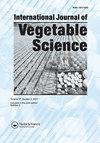木薯贮藏根采后生理抗劣性鉴定的品种筛选
IF 1.1
Q2 Agricultural and Biological Sciences
引用次数: 0
摘要
摘要木薯采后生理变质是制约木薯生长的重要因素,对木薯根茎的有效利用构成威胁。本研究确定了木薯基因型对PPD耐受性的变异程度,并确定了对PPD耐受性的新来源。在收获后3、5、7、10、15和20天的评估间隔内,对76种木薯基因型进行了PPD耐受性评估。重复测量分析表明,PPD的差异可靠地依赖于时间、基因型和年份。使用包括标准化平均差、PPD和每日PPD在内的秩和统计将基因型分为9类。19个基因型具有耐受性,3个基因型在收获后20天内无症状。与地方品种和预选系相比,释放品种对PPD具有耐受性。PPD症状主要发生在根的周围区域和近端和远端,而不是根的中间区域。根颈的存在减少了恶化。根长、根重和干物质含量与PPD呈正相关。新的耐受性来源可以提高木薯的采收和利用。作者感谢印度农业研究理事会-中央块茎作物研究所所长为开展这项工作提供了必要的设施。披露声明作者未报告潜在的利益冲突。本文章由计算机程序翻译,如有差异,请以英文原文为准。
Varietal screening for identification of postharvest physiological deterioration tolerance in storage roots of cassava
ABSTRACTPostharvest physiological deterioration (PPD) is a constraint in cassava (Manihot esculenta Crantz) and a threat to effective utilization of cassava roots. This study determined the magnitude of variability for PPD tolerance among cassava genotypes and identified new sources of tolerance to PPD. Seventy-six cassava genotypes were evaluated for PPD tolerance at postharvest evaluation intervals of 3, 5, 7, 10, 15, or 20 days after harvest. Repeated measure analysis indicated that differences for PPD reliably depend on time in conjunction with genotype and years. The genotypes were categorized into nine classes using rank-sum statistics involving standardized mean range, PPD, and PPD per day. Nineteen genotypes were tolerant and three were free of symptoms up to 20 days postharvest. Released varieties had tolerance to PPD compared to local varieties and pre-breeding lines. The PPD symptoms were mostly found in peripheral regions and in proximal and distal ends rather than in the mid-region of the root. The presence of the root neck reduced deterioration. Root length, weight, and dry matter content were positively correlated with PPD. The new sources of tolerance may improve the adoption and utilization of cassava.KEYWORDS: Manihot esculentavariabilityrepeated measuresrank sum analysis AcknowledgmentsThe authors thank the Director, Indian Council of Agricultural Research-Central Tuber Crops Research Institute for providing necessary facilities to carry out this work.Disclosure statementNo potential conflict of interest was reported by the author(s).
求助全文
通过发布文献求助,成功后即可免费获取论文全文。
去求助
来源期刊

International Journal of Vegetable Science
Agricultural and Biological Sciences-Plant Science
CiteScore
3.10
自引率
0.00%
发文量
30
期刊介绍:
The International Journal of Vegetable Science features innovative articles on all aspects of vegetable production, including growth regulation, pest management, sustainable production, harvesting, handling, storage, shipping, and final consumption. Researchers, practitioners, and academics present current findings on new crops and protected culture as well as traditional crops, examine marketing trends in the commercial vegetable industry, and address vital issues of concern to breeders, production managers, and processors working in all continents where vegetables are grown.
 求助内容:
求助内容: 应助结果提醒方式:
应助结果提醒方式:


